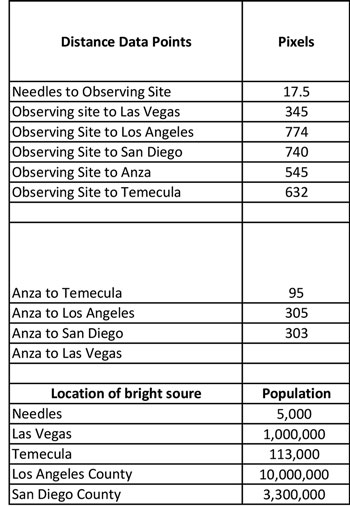Greetings from Palmia Observatory
Well, here we are evaluating a good site from which to see or at least photograph the Zodiacal light. Yep, OCA Dave reminds us that it shows up quite often in photographs from Anza observing site.
Check out Dave's image, with 30 second exposure and ISO 3200 camera setting, taken during a meteor shower in 2015. Thanks for letting us know about it, Dave! Thanks too for all the other OCA members who commented about how, when and where the lights can be seen!
 |
| Photograph the Zodiacal light from Anza (Source: OCA Dave Kodama, 2015, www.astrocamera.net) |
So, photographing the Zodiacal light has never been on my observing schedule, but after seeing some great images, like the one from Canary Islands as reported on in the last week's blog post, I wanted to find a good location from which to make my first attempt.
Now I didn't want to drive to Anza to try, but we are planning a trip that takes us through Las Vegas to see family relatives in the next couple of weeks and wondered if there wasn't some other drive that would accomplish the family meeting but could also contain a viewing opportunity. To that end, I found a potential site outside of Needles, CA, which just extends our drive by a night and a couple of hundred miles, but it would be a welcome opportunity. If we spent the night in a hotel in Needles, we could just drive out of town a few miles, say 5 miles to the old airport or other dark spot and make our first attempt.
Let's use this map of the area to see if we can estimate how bright the sky would be there in comparison to Anza by assuming that we can just estimate the amount of light from big city areas and take the squared distance to sum up the light pollution.
 |
| Map section from iPad screenshot used to estimate distances (Source: Palmia Observatory) |
Assume the map is for a flat Earth and just count pixels and compare the relative distances. To convert to miles, the pixel distance from Victorville and Barstow was used to set the scale of 112 pixels equals 32 miles. The other distances were just measured from the map. We also assume that large city area populations can be used as a proxy for the amount of sky light pollution.
 |
| Using population as proxy for light pollution (Source: Palmia Observatory) |
So, now we can just sum up the assumed light sources, using an inverse square law for the distances involve and get an estimate of the comparative sky brightness. This is just a simple estimate and does not take into account many other factors.
The scattered light from these city lights will come back to our cameras along the whole field of view, but let us consider just two points for comparison. These two points differ in that the 2nd one is moved westward as an attempt to capture the scattered light along our path to the Zodiacal light. We can see that the city of Needles itself, being just say 5 miles from the proposed observation site, can be quite bright in the night sky. So, if we assume the scattered lights comes from the west, we can compare with one other point just 5 miles, double the initial distance, away and take these two points as the sum of polluted light. Of course, the actual calculation would be more complicated, taking into account air density and all sorts of other factors, but we can get a sense as to the comparative darkness.
In this next chart, we see that the impact of large lit areas like San Diego and Los Angeles have big impact on the sky brightness at Anza. Is this something that other OCA can confirm? But, with this simple approach, it seems that we might expect the sky at Needles observation point to experience about 4 times less in light power per square meter, for example.
 |
| Brightness estimate shows Needles site expected to be darker than Anza (Source: Palmia Observatory) |
Anyway, this suggests that we can extend out drive and travel time on our upcoming trip and still maybe have good dark sky for our Zodiacal light adventure. Besides Needles will have hotel rooms and martini bars, which Anza does not! Now if we can only keep the clouds away.
Until next time, here from our burrow, stay safe, as we recover more of our freedom,

No comments:
Post a Comment